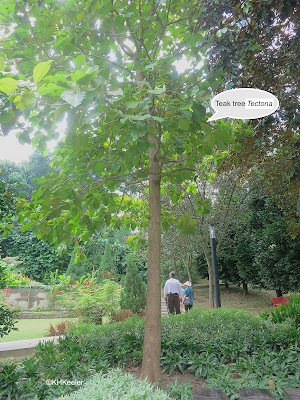This is a mint
 |
| henbit, Lamium amplexicaule |
 |
| coleus, genus Coleus |
and this is a mint
 |
| scarlet beebalm, Monarda didyma |
This is also a mint
 |
| teak, Tectoma |
Wait a minute! All of those? They don't look like spearmint (Mentha spicata)
 |
| spearmint, Mentha spicata |
It depends on how you use the word mint. All those plants are members of the same plant family, the Lamiaceae, often called the mint family. As members of the family, it is customary to call them mints, just as we call members of the family Poaceae grasses and of the family Arecaceae palms.
But the Lamiaceae is large. There are currently 238 genera and 7000 to 7,400 species making it the sixth-largest plant family. That is plenty of room for diversity.
I first said "that's a mint? Really?" when I learned about the culinary herbs. Spearmint and peppermint (Mentha xpiperita) are in the Lamiaceae, but so are culinary sage (Salvia officialis), rosemary (Salvia rosmarinus), basil (Oncimum basilicum), oregano (Origanum vulgare) and majoram (Origanum majorana), garden thyme (Thymus vulgaris), and English lavender (Lavendula angustifolia). They smell vety different, have leaves of different shapes...lots of differences. But all have square stems, a distinctive smell, and flowers with the narrow, "lip" shape as seen in the catmint (Nepeta racemosa) below. (Yes, catnip, Nepeta cataria, is also a mint.) DNA studies agree they are closer to each other than any other plants and should be grouped as a plant family.
 |
| catmint, Nepeta racemosa |
The alternate name for the family, Labiatae, refers to the lips; the upper and lower petals are fused and appear to be lips, labia in Latin. Both the name Lamiaceae and Labiatae are correct names for the family. A compromise at the International Botanical Congress that approved naming every family after a genus within the family grandfathered in the traditional names of nine beloved families; one was this family. The name Lamiaceae is based on Lamium, a genus which includes dead nettles (below) and henbit (top photo.)
 |
| spotted deadnettle, Lamium maculatum |
Saying the Lamiaceae is the mint family is only a convenience, naming a plant in that family that others are likely to recognize. We can as easily say the deadnettle family or the sage family...in which case all my pictures at the top of this blog could be labeled deadnettles or sages. Or, you could say the catnip or teak family, there are hundreds of possibilities.
Lamiaceae clearly comprise a disproportionate number of our culinary herbs. Other members of the family have traditional medicinal uses or, like spearmint, are grown commercially as flavorings. There are only a few species which are woody, rosemary for example, and even fewer are trees, most prominently the teaks.
They are found all over the world. With 7,000 species, I don't have have photos of even 10% of them, but here are a couple more:
 |
| starburst, Clerodendrum quadriloculare |
 |
| lamb's ears, Stachys byzantina |
 |
| basil, Ocimum basilicum |
 |
| creeping thyme, Thymus serpyllum |
 |
| giant hyssop, Agastache |
This is a cool family. They are economically important. They are easy to recognize; the square stems, which are almost universal in the Lamiaceae, are on only one other plant family, the Verbenaceae and the verbenas don't have fragrant leaves, plus flowering plants have lip-like flowers. Flowers and leaves in the Lamiaceae are varied, bright and quite beautiful. And the mints are relatively common, both as ornamentals and wildflowers.
I wish I could include the scent of mint or sage or basil in this post. You'll have to find those plants and savor the fragrance for yourself. Watch for pollinators too. Lamiaceae are very attractive to pollinators, from bees to butterflies to hummingbirds.
I am an herbalist and growing what looks like a peppermint, but it has no smell. I live in Austin Texas and want to know if this plant has medicinal properties, despite its lack of scent. Can you help?
ReplyDeleteSquare stems? mint-like flower? Right family probably. But there are 7,000 species and Austin will have dozens, native and introduced. Can you use google's photo recognition option or load it to iNaturalist or post it to the Facebook site Plant Identification. Lemon balm (Melissa)? catnip (Nepeta)? Those are common weedy mints, usually with a scent but you could have the rare one that seems scentless.
ReplyDelete